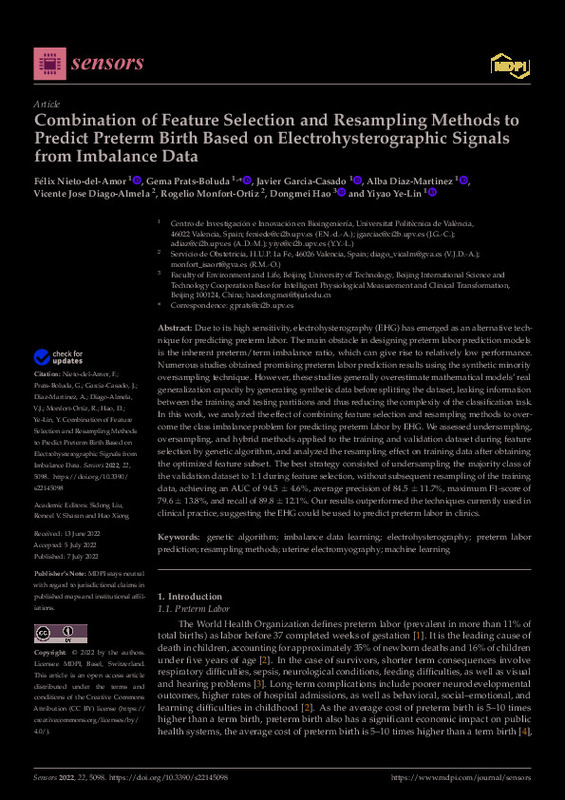JavaScript is disabled for your browser. Some features of this site may not work without it.
Buscar en RiuNet
Listar
Mi cuenta
Estadísticas
Ayuda RiuNet
Admin. UPV
Combination of Feature Selection and Resampling Methods to Predict Preterm Birth Based on Electrohysterographic Signals from Imbalance Data
Mostrar el registro sencillo del ítem
Ficheros en el ítem
| dc.contributor.author | Nieto del-Amor, Félix
|
es_ES |
| dc.contributor.author | Prats-Boluda, Gema
|
es_ES |
| dc.contributor.author | Garcia-Casado, Javier
|
es_ES |
| dc.contributor.author | Diaz-Martinez, Alba
|
es_ES |
| dc.contributor.author | Diago-Almela, Vicente Jose
|
es_ES |
| dc.contributor.author | Monfort-Ortiz, Rogelio
|
es_ES |
| dc.contributor.author | Hao, Dongmei
|
es_ES |
| dc.contributor.author | Ye Lin, Yiyao
|
es_ES |
| dc.date.accessioned | 2023-01-19T19:01:05Z | |
| dc.date.available | 2023-01-19T19:01:05Z | |
| dc.date.issued | 2022-07-07 | es_ES |
| dc.identifier.uri | http://hdl.handle.net/10251/191405 | |
| dc.description.abstract | [EN] Due to its high sensitivity, electrohysterography (EHG) has emerged as an alternative technique for predicting preterm labor. The main obstacle in designing preterm labor prediction models is the inherent preterm/term imbalance ratio, which can give rise to relatively low performance. Numerous studies obtained promising preterm labor prediction results using the synthetic minority oversampling technique. However, these studies generally overestimate mathematical models¿ real generalization capacity by generating synthetic data before splitting the dataset, leaking information between the training and testing partitions and thus reducing the complexity of the classification task. In this work, we analyzed the effect of combining feature selection and resampling methods to overcome the class imbalance problem for predicting preterm labor by EHG. We assessed undersampling, oversampling, and hybrid methods applied to the training and validation dataset during feature selection by genetic algorithm, and analyzed the resampling effect on training data after obtaining the optimized feature subset. The best strategy consisted of undersampling the majority class of the validation dataset to 1:1 during feature selection, without subsequent resampling of the training data, achieving an AUC of 94.5 ± 4.6%, average precision of 84.5 ± 11.7%, maximum F1-score of 79.6 ± 13.8%, and recall of 89.8 ± 12.1%. Our results outperformed the techniques currently used in clinical practice, suggesting the EHG could be used to predict preterm labor in clinics. | es_ES |
| dc.description.sponsorship | This work was supported by the Spanish Ministry of Economy and Competitiveness, the European Regional Development Fund (MCIU/AEI/FEDER, UE RTI2018-094449-A-I00-AR), and by the Generalitat Valenciana (AICO/2019/220) | es_ES |
| dc.language | Inglés | es_ES |
| dc.publisher | MDPI AG | es_ES |
| dc.relation.ispartof | Sensors | es_ES |
| dc.rights | Reconocimiento (by) | es_ES |
| dc.subject | Genetic algorithm | es_ES |
| dc.subject | Imbalance data learning | es_ES |
| dc.subject | Electrohysterography | es_ES |
| dc.subject | Preterm labor prediction | es_ES |
| dc.subject | Resampling methods | es_ES |
| dc.subject | Uterine electromyography | es_ES |
| dc.subject | Machine learning | es_ES |
| dc.subject.classification | TECNOLOGIA ELECTRONICA | es_ES |
| dc.title | Combination of Feature Selection and Resampling Methods to Predict Preterm Birth Based on Electrohysterographic Signals from Imbalance Data | es_ES |
| dc.type | Artículo | es_ES |
| dc.identifier.doi | 10.3390/s22145098 | es_ES |
| dc.relation.projectID | info:eu-repo/grantAgreement/AEI/Plan Estatal de Investigación Científica y Técnica y de Innovación 2017-2020/RTI2018-094449-A-I00/ES/ELECTROHISTEROGRAFIA PARA LA MEJORA EN LA TOMA DE DECISIONES EN SITUACIONES DE RIESGO EN OBSTETRICIA: PARTO PREMATURO E INDUCCION DEL PARTO/ | es_ES |
| dc.relation.projectID | info:eu-repo/grantAgreement/GENERALITAT VALENCIANA//AICO%2F2019%2F220//DESARROLLO DE HERRAMIENTAS DE USO CLINICO PARA LA PREDICCION DEL PARTO PREMATURO EN BASE A LA ELECTROHISTEROGRAFIA/ | es_ES |
| dc.rights.accessRights | Abierto | es_ES |
| dc.contributor.affiliation | Universitat Politècnica de València. Escuela Técnica Superior de Ingenieros Industriales - Escola Tècnica Superior d'Enginyers Industrials | es_ES |
| dc.contributor.affiliation | Universitat Politècnica de València. Escuela Técnica Superior de Ingeniería del Diseño - Escola Tècnica Superior d'Enginyeria del Disseny | es_ES |
| dc.description.bibliographicCitation | Nieto Del-Amor, F.; Prats-Boluda, G.; Garcia-Casado, J.; Diaz-Martinez, A.; Diago-Almela, VJ.; Monfort-Ortiz, R.; Hao, D.... (2022). Combination of Feature Selection and Resampling Methods to Predict Preterm Birth Based on Electrohysterographic Signals from Imbalance Data. Sensors. 22(14):1-18. https://doi.org/10.3390/s22145098 | es_ES |
| dc.description.accrualMethod | S | es_ES |
| dc.relation.publisherversion | https://doi.org/10.3390/s22145098 | es_ES |
| dc.description.upvformatpinicio | 1 | es_ES |
| dc.description.upvformatpfin | 18 | es_ES |
| dc.type.version | info:eu-repo/semantics/publishedVersion | es_ES |
| dc.description.volume | 22 | es_ES |
| dc.description.issue | 14 | es_ES |
| dc.identifier.eissn | 1424-8220 | es_ES |
| dc.identifier.pmid | 35890778 | es_ES |
| dc.identifier.pmcid | PMC9319575 | es_ES |
| dc.relation.pasarela | S\469903 | es_ES |
| dc.contributor.funder | GENERALITAT VALENCIANA | es_ES |
| dc.contributor.funder | AGENCIA ESTATAL DE INVESTIGACION | es_ES |
| dc.subject.ods | 03.- Garantizar una vida saludable y promover el bienestar para todos y todas en todas las edades | es_ES |
| dc.subject.ods | 10.- Reducir las desigualdades entre países y dentro de ellos | es_ES |
| upv.costeAPC | 2100 | es_ES |








